-
Content Count
145 -
Joined
-
Last visited
Posts posted by Andrewfly fishing
-
-

This Czech Nymph pattern is one of favorite. Czech nymphing is a specific type of fishing that was developed in the Czech republic and Poland for fishing in moderate to fast water. The flies they created mimic many of the caddis nymphs and fresh water shrimps that inhabit most waters all over the world.
The two main components of the fly are the shellback material and the over all slim shape of the nymph. The slim profile helps the fly sink quickly through the water column and the shellback material known as Magic Shrimp Foil has both a shiny and dull side unlike other similar products. Fish these flies two or even three at a time and start catching fish where you would have not even considered fishing before.
___________________________________________________________________
Material list

Hook: Shrimp any type, size 8-14
Thread: White Hyperfine thread
Weighting: Lead wire, the size depends on the hook size and weight of the fly
Abdomen ribbing: Pearl tinsel
Back shield ribbing: 0.15 mm (5X) light grey monofilament
Abdomen: Siman Czech Nymph Body Dubbing - olive or Siman Softdub JS Dubbing #35 olive
Hot spot: Fluo pink dubbing or dubbing brush
Thorax: Dark dubbing (black thorax dubbing) or Siman Softdub Squirrel Plus #05 black
Back shield: Siman Magic Shrimp Foil #08 Light Brown
___________________________________________________________________
Instructions

Step 1: Cover the hook shank with lead wire. Begin a little way round the hook bend, make tight windings, and remove the excess wire. For deep running nymphs use two layers of wire. For the first layer use thicker wire and finer wire for the second layer and form the smooth shape of lead underbody. For very heavy nymphs use tungsten wire (but it is not easy to work with). To avoid displacement of the lead body while you are tying in the other materials, you can add a layer of super glue on the shank before you wind on the lead wire.

Step 2: Add a layer of head cement to the lead wire. The head cement fills the spaces between wire windings and makes a more compact body.

Step 3: Cover the lead underbody with white tying thread and make carefully tapered edges on the ends of the lead wire. The white thread is soaked with varnish, as applied in step 2, and keeps the fly body colour when fishing the fly. You could try colored threads to change the body colour when soaked with water.

Step 4: Tie the back shield, 0.15 mm (5X) monofilament (back shield ribbing) and pearl tinsel (abdomen ribbing) well into the hook bend. Changing the hook position helps to tie materials down the hook bend and makes for a more curved fly. To secure the monofilament tie a knot on its end before tying it in.

Step 5: Make a thin tapered olive dubbing rope, put it into the dubbing loop, and twist it using dubbing twister or use Softdub. Softdubs (especially in natural colors) make great Czech nymph bodies.

Step 6: Wind the tapered abdomen, cover between 2/3 and 3/4 only of the body of the fly.

Step 7a: Brush the abdomen using a Velcro brush to make the fuzzy silhouette and slimmer body core.

Step 7b: Use a pair of scissors on the back abdomen and carefully trim all extending fibers, to make a nice tapered back to the fly.

Step 8: Create abdomen ribs with five to eight windings of pearl tinsel.

Step 9: Dub a small fluo pink hot spot onto the thread or use a dubbing loop.

Step 10: Make the hot spot with two or three turns and trim extending fibers.

Step 11: Dub the thorax dubbing into a dubbing loop or tie the thorax using Softdub

Step 12: Wind it tightly forward towards the eye of the hook.

Step 13a: Pull the back shield over the body to the hook eye.

Step 13b: Pull the back shield tight and secure it with several winding of tying thread.

Step 14: Rib the back shield with the monofilament. Not too many ribs, five to eight are enough, and not too tight.

Step 15a: Use a waterproof pen to color the head. Consider a simple weighting system:
* no weight = green head
* medium weight (one layer of lead) = brown head
* heavy weight (two layers of lead) = black head.

Step 15b: You can color the thread first and then tie the colored head.

Step 16: Finally apply the head cement and the fly is finished.
___________________________________________________________________
Finished fly




___________________________________________________________________
Cheers,
Jan
P.S. More Czech Nymph patterns coming soon...
very self explanitory
-
-
could you show me how to ty it pleas.



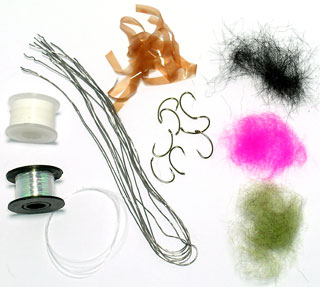






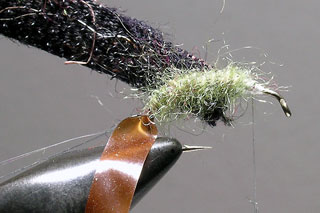
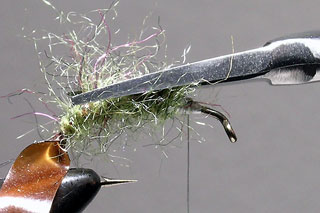





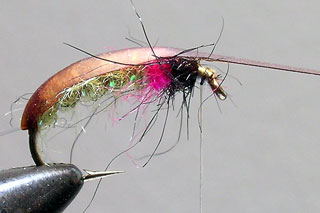
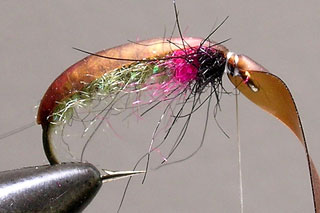

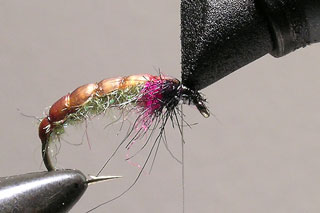
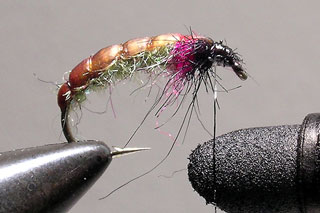

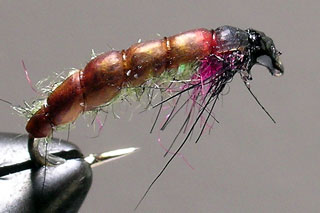
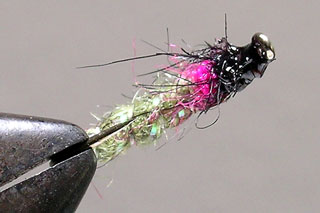
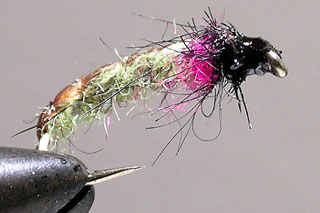
Hatches Magazine: Chris Helm Interview
in The Fly Tying Bench
Posted · Report reply
Nice fly! I love youre choice in coloure. Red is a killer on bass